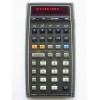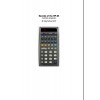Background
The HP-65 calculator was the first ever pocket programmable calculator. It had never been done before.
There were computers that you could program and these had been miniaturized so much that you could now fit them on a desk. You needed to understand programming languages and with some formal training, some aptitude and persistence; you’d eventually be able to make them do useful things.
There were also calculators. Before the HP-65, they were mainly four function devices. They would add, subtract, multiply and divide. Hewlett-Packard came along and changed that significantly. Just have a look into the history of the HP-35 calculator. Whilst calculators had been gradually expanding to include, in high-end models, a square root key; Hewlett-Packard introduced a whole new class of calculators – the scientific calculator. Virtually overnight, an entire industry, that of slide rules and four-figure mathematical tables, vanished as a consequence. Instead, we developed many other industries that could now do so much more, so much faster and with greater accuracy and fewer mistakes than ever before.
You’d have thought that Hewlett-Packard, HP, would have been content with having changed the world. They made history. They got written up as part of it. The world significantly changed for the better because of what they’d introduced. That should have been the end of the story.
But then, they introduced the HP-65.
That merged two worlds: the computing one and the calculator industry and consumer one.
For the first time you could write computer programs wherever you were. For the first time you didn’t need to learn computer languages to talk to them. For the first time you could try out and learn programming techniques in the time it took to hear about them.
The HP-65 combined the power and simplicity of a pocket calculator with the ability of a computer to analyze data and to make decisions based on the data.
Instead of programming being something some people learn after a university course, the right guidance and lots of experience; ordinary people could do it too. Engineers, general scientists and chemists no longer had to wait for time on a facility computer and assistance from the computer science department. But it wasn’t just engineers and scientists – it was real estate agents, surveyors, sales people, pilots and accountants too. Anyone that ever needed to do the same, or similar, calculations more than once; suddenly had the power of a computer in the palm of their hand.
Many, many people – myself included – learnt programming and about computers as a result of the invention of the HP-65 programmable calculator.
You can read more about the HP-65 calculator on the HP-65 wikipedia page.
There is additional information on it at the HP-65 page of the (unofficial) HP museum site.
Buying a HP-65 Calculator
At the time you could get one from HP for around $800 but that was a long time ago and they have stopped making them. Many people have become collectors so there are still some in existence and you could probably get someone to part with one for a large enough sum of money.
That said, they are old and things do age so price and condition trade offs are possible. There are usually some HP-65 calculators available on ebay. The things to consider are:
- the condition of the battery, and
- the condition of the card reader.
That is in addition to basics like: does it work, what condition is it in, what is the lettering like?
The battery pack was custom made and replacing it is possible but it isn’t straightforward.
The “rubber” wheel that runs the magnetic cards through the card reader melts with time (becomes “gummy”). It was a great idea at the time and it was the best possible material that met the requirements; but it didn’t stay that way for 40 years. Repairs / replacements are possible but these require dismantling and reassembling.
The HP-65 calculator keys were injection moulded with the lettering built into them. The only way the lettering on the keys wears out is if the entire key gets worn through. That will never happen. The lettering on the board around the keys is another matter. That does wear off.
The HP-65 is considered sufficiently valuable that people are even asking the same price as when it was brand new and the only thing of its kind in the world. It was very impressive then. It is mostly impressive now because it was so impressive then. But that’s impressive too. They aren’t making any more of them. If you can get one you’ll be among the fortunate few.
If you’re fine with something that isn’t quite the real thing, you might be interested in some of the rebuilds using modern hardware eg the teenix printed circuit board or the panamatik ACT Chip replacement.
HP-65 Emulators
Probably most of us get by with software emulators. There are a range of those with different features. Some emulate at a high level (it has the same buttons and it does the same things). Others emulate at a lower level (same buttons and same functionality because it works the same way internally). As with most software, different emulators are available for different operating systems.
I make one of the emulators and there is a link to it further down the page. I like my emulator because it runs on any operating system, any phone and any tablet; because it runs the exact same microcode instructions as the real calculator; and because it even looks the same as the real calculator.
You can run my HP-65 emulator for free in any web browser on any computer and, if you “install it”, you can even run it when you’re not connected to the internet.
You can also buy a copy of my emulator for a nominal sum if you’re interested in seeing what’s inside it and how it works, or if you just like to make sure you always have it. See the link for details.
Whilst I think my emulator is the best; your needs and preferences may differ. There are some things I can’t do from within a browser, such as direct access to files on your computer. You can load and save programs with my emulator but, because the user has to be involved (agree), there are a few extra steps. A program that only runs on your phone or only under the Windows operating system will usually have unrestricted access to files. The downside to those programs is that you usually need a different program for each of your devices.
Which is best for you depends on you. Some of the other emulators available are:
Jacques Laporte – Java HP-65 emulator
Francois Roulet – Javascript HP-65 emulator
Tony Nixon – CCE and the HP-65 module (Windows OS).
Using the HP-65 Calculator
The manual is available online at the cuveesoft.ch website as HP-65 Owners Handbook.
Some HP-65 calculator programs are available from:
HP-65 calculator programs
Articles I’ve written on the calculator can be found at HP-65 articles.
There is a help page for the calculator (and emulators) at HP-65 Help
Products
Here is a list of HP-65 calculator items that I have available. You can click a picture for a bigger view of the picture, or the name of an item for more information about it.


